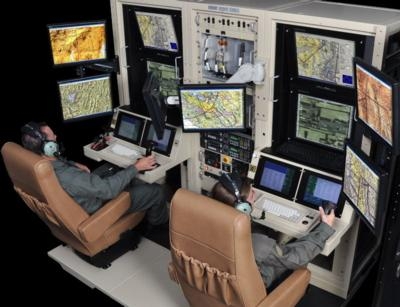Wed, Jan 27, 2016
Will Build 34 Predator Mission Aircrew Training Systems
The U.S. Air Force has awarded a contract option to L-3 Link Simulation & Training (L-3 Link) to build 34 new Predator Mission Aircrew Training System (PMATS) simulators. The contract was awarded by the U.S. Air Force’s Life Cycle Management Center at Wright-Patterson Air Force Base.

“The U.S. Air Force’s and U.S. Air National Guard’s requirements for MQ-1 Predator and MQ-9 Reaper pilots and sensor operators continue to grow, and the skills needed to complete an expanding set of missions are increasingly complex,” said Frank Casano, L-3 Link’s vice president of programs. “These training devices will provide an unparalleled level of realism and immerse both new and experienced crews in challenging training scenarios based on today’s mission requirements.”
The new PMATS simulators will be used to train Predator and Reaper pilot and sensor operator crews. PMATS training devices, in addition to associated equipment and systems, will be delivered to 15 installations between the U.S. Air Force and U.S. Air National Guard.
The L-3 Link-developed and -produced PMATS training solution has been supporting training for the U.S. Air Force and U.S. Air National Guard since initial devices were delivered in 2007. L-3 Link, under previously awarded contracts, has fielded or is continuing to build 33 PMATS devices. This new award for 34 additional PMATS simulators will result in L-3 fielding a combined total of 67 Predator and Reaper trainers to support the services’ crew training objectives.
Under this contract option, L-3 Link will integrate its simulation environment solution with ground control stations supplied by the U.S. Air Force. L-3 Link’s simulation solution combines a physics-based image generator, Synthetic Automated Forces generator, instructor station, and other training system hardware and software. PMATS training devices create a high-fidelity environment that simulates aircraft performance, weapons, sensors, communications, data link operations, emergencies, degraded video feeds and environmental conditions. On these simulators, Predator and Reaper crews undergo initial qualification, mission qualification, continuation and mission rehearsal training.
(Image provided with L-3 Link news release)
More News
He Attempted To Restart The Engine Three Times. On The Third Restart Attempt, He Noticed That Flames Were Coming Out From The Right Wing Near The Fuel Cap Analysis: The pilot repor>[...]
Make Sure You NEVER Miss A New Story From Aero-News Network Do you ever feel like you never see posts from a certain person or page on Facebook or Instagram? Here’s how you c>[...]
From 2009 (YouTube Edition): Leading Air Show Performers Give Their Best Advice for Newcomers On December 6th through December 9th, the Paris Las Vegas Hotel hosted over 1,500 air >[...]
Aero Linx: NASA ASRS ASRS captures confidential reports, analyzes the resulting aviation safety data, and disseminates vital information to the aviation community. The ASRS is an i>[...]
“For our inaugural Pylon Racing Seminar in Roswell, we were thrilled to certify 60 pilots across our six closed-course pylon race classes. Not only did this year’s PRS >[...]
 NTSB Final Report: Rutan Long-EZ
NTSB Final Report: Rutan Long-EZ ANN FAQ: Turn On Post Notifications
ANN FAQ: Turn On Post Notifications Classic Aero-TV: ICAS Perspectives - Advice for New Air Show Performers
Classic Aero-TV: ICAS Perspectives - Advice for New Air Show Performers ANN's Daily Aero-Linx (06.28.25)
ANN's Daily Aero-Linx (06.28.25) Aero-News: Quote of the Day (06.28.25)
Aero-News: Quote of the Day (06.28.25)



